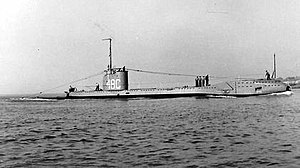HMS Undine (N48)
 HMS Undine
| |
| History | |
|---|---|
| Name | HMS Undine |
| Builder | Vickers Armstrong, Barrow-in-Furness |
| Laid down | 19 February 1937 |
| Launched | 5 October 1937 |
| Commissioned | 21 August 1938 |
| Fate | Scuttled 7 January 1940 |
| Badge |  |
| General characteristics | |
| Class and type | U-class submarine |
| Displacement |
|
| Length | 58.22 m (191 ft 0 in) |
| Beam | 4.90 m (16 ft 1 in) |
| Draught | 4.62 m (15 ft 2 in) |
| Propulsion |
|
| Speed |
|
| Complement | 27 |
| Armament |
|
HMS Undine was a U-class submarine and lead vessel of her class, which is sometimes called the Undine class as a result. The submarine entered service in 1938. Undine performed war patrols during the Second World War and was scuttled after being damaged by German minesweepers off Heligoland on 7 January 1940.
Construction and career
Undine was built by Vickers Armstrong, Barrow-in-Furness. She was laid down on 19 February 1937 and was commissioned on 21 August 1938 with the pennant number N48.
At the onset of the Second World War, Undine was a member of the 6th Submarine Flotilla. From 26–29 August 1939, the flotilla deployed to its war bases at Dundee and Blyth.[1]
Sinking
Undine was on her fourth war patrol in January 1940 when her sonar failed due to a leak. At 0940 on 7 January, she sighted what was thought to be three trawlers 20 miles (32 km) west of Heligoland; but were in fact the German auxiliary minesweepers M-1201, M-1204 and M-1207. She unsuccessfully attacked the leading vessel, but the minesweepers counter attacked and forced her to dive. Undine was at 50 feet (15 m) and proceeding blind due to the loss of sonar. After five minutes with no further attacks, she raised her periscope. As she did so, an explosion shook the submarine, blowing her upwards and rendering the hydroplanes useless. Without the use of the hydroplanes, escape would have been impossible and the order to abandon ship was given. Whilst the crew entered the water, to be picked up by the minesweepers, Undine was scuttled.[2][3]
See also
Notes
- ^ Rohwer, p.1
- ^ "Submarine losses 1904 to present day". RN Submarine Museum, Gosport. Archived from the original on 8 August 2007.
{{cite web}}: Unknown parameter|deadurl=ignored (|url-status=suggested) (help) - ^ "HMS Undine (i) (N 48)". uboat.net. Retrieved 9 April 2016.
References
- Colledge, J. J.; Warlow, Ben (2006) [1969]. Ships of the Royal Navy: The Complete Record of all Fighting Ships of the Royal Navy (Rev. ed.). London: Chatham Publishing. ISBN 978-1-86176-281-8.
- Hutchinson, Robert (2001). Jane's Submarines: War Beneath the Waves from 1776 to the Present Day. London: HarperCollins. ISBN 978-0-00-710558-8. OCLC 53783010.
- Rohwer, Jürgen (2005). Chronology of the War at Sea 1939—1945: The Naval History of World War Two (Revised & Expanded ed.). Annapolis, Maryland: Naval Institute Press. ISBN 1-59114-119-2.
